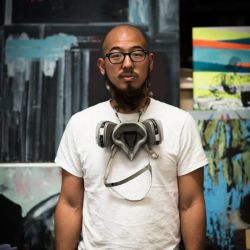Borrowing from specific cultural history to talk about the universal ideas of the human condition.
My work is related to family history, memory and identity. Most of what I do stems from a sense of loss or longing, looking for a place to belong. As a child, I remember being loaded into my parents’ car, paper and pencil in hand, for the hour and a half journey to my grandfather’s motel in Lake Elsinore. It was a literal desert hot spring oasis. My entire family would converge there, five aunts and five uncles, their children, grandparents, even a great grandparent. We would play in the pool all day and then feast into the night. But with death, divorce, illness and disagreements, this utopian world only remains as a memory and in aging photographs. I pine for that once again, this sentiment I’m sure shaped the choices I made for many of my formative years growing up in Los Angeles, getting involved with gangs and graffiti at their height, and even a fraternity in college, always looking for that place to belong. Much of my work pertains to this idea of preservation, recreation, with this obsession to document, and ultimately, thematically, to this idea of “home” – defining it, seeking it, losing it, our relationship to it.
I appropriate symbols, patterns, colors, traditions from the culture that feels so familiar to me, but as I get older, I realize, outside of intentional research, I don’t truly understand the meanings of those things. I may look Korean on the outside but an attempt to integrate into modern Korean society will quickly demonstrate that I am otherwise. To further complicate things, the little of Korea that I know was gleaned from a family who left it in the 1970s never to look back, and so a Korea frozen in time was handed down to me essentially, while the mother country is currently and rapidly distancing itself from its history. I then find myself a foreigner to the land 6,000 miles away, yet hopelessly drawn to it because it holds secrets to who I am. The circumstances, wars, culture, decisions that shaped my great grandparents, shaped all the subsequent generations, and hold the keys to my parents and finally me. I choose the images from this particular culture as proxy for more universal subject matter. Sometimes I will adorn walls with these familiar patterns thereby making a strange place more like home.
In dealing with that sense of loss in the present, contemporarily, I collect things such as biomatter as a way to literally amass time and save life in the form of DNA. In my West Oakland neighborhood, the detritus I see immediately around me and the ethos it represents affects me and compels me to pay attention. As an example, where I live, the passing of life is symbolized in the form of posters, candles, flowers, stuffed animals, balloons, makeshift shrines to those who have been killed, usually due to violence. Over time these things turn into debris, adding to the already existing piles of trash. To me they form sculptures of history – balloons with piles of scrap wood against a slatted fence – and tell a story of that place, an instant visual that needs little explanation.
“Home” is the idea that we’re looking to return to the place we felt most loved and nurtured. It may or may not be a physical place or an image in our heads, but ultimately it’s a lost cause. We cannot go back in time to that moment and relive it. Places morph; memories falter. The best we can hope for is to recreate a subpar version or do something similar for our own progeny. My work plays with that idea of manufacturing nostalgia. I document the awkward relationship of attempting to relate the past with a brand new home, my first. As violence or gentrification shift the shapes around my current dwelling as well as those living here or pressured to move out, circumstance or force strips refugees of their homes and also of the hope to return to it or even a version of it one day.
